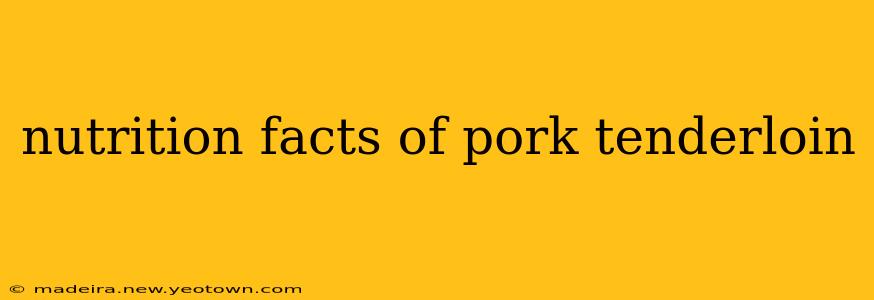Pork tenderloin. The name itself conjures images of succulent meals, juicy roasts, and flavorful additions to countless dishes. But beyond its culinary appeal lies a nutritional powerhouse often overlooked. Let's delve into the fascinating world of pork tenderloin nutrition, uncovering its benefits and addressing common questions.
This isn't just another nutrition facts rundown; this is a story about a cut of meat that's surprisingly versatile and packed with goodness. Imagine a lean protein source that's easily adaptable to various cuisines and dietary needs. That's the magic of pork tenderloin.
What are the nutrition facts of pork tenderloin?
A 3-ounce serving of cooked pork tenderloin typically contains:
- Calories: Approximately 130-150
- Protein: Around 25-30 grams – a fantastic source for building and repairing tissues.
- Fat: Generally low, ranging from 3-5 grams, mostly unsaturated fats. This makes it a healthier alternative to many other cuts of pork.
- Cholesterol: Relatively low, usually under 70mg.
- Sodium: This can vary depending on preparation methods. Opt for minimal seasoning to keep sodium intake lower.
- Vitamins and Minerals: Pork tenderloin is a good source of thiamin, niacin, vitamin B6, and selenium, all vital for various bodily functions. It also offers a decent amount of iron and zinc.
Is pork tenderloin healthy?
Absolutely! When compared to other cuts of pork, tenderloin stands out for its remarkably low fat content. It's a lean protein that fits comfortably into a healthy, balanced diet. The high protein content makes it ideal for muscle growth and repair, while the vitamins and minerals contribute to overall well-being. Remember, however, how you prepare it significantly impacts its overall health profile. Over-seasoning with salt or frying it in excessive oil will negate some of these benefits.
How much protein is in pork tenderloin?
As mentioned above, a 3-ounce serving boasts an impressive 25-30 grams of protein. This makes it an excellent choice for individuals looking to increase their protein intake, whether for muscle building, weight management, or general health. Protein is essential for numerous bodily functions, from hormone production to immune system support.
Is pork tenderloin good for weight loss?
Because of its lean nature and high protein content, pork tenderloin can absolutely be part of a weight-loss diet. Protein keeps you feeling fuller for longer, reducing cravings and potentially decreasing overall calorie intake. However, portion control remains key, and mindful preparation is crucial to avoid adding unnecessary fats and calories.
How many calories are in pork tenderloin?
A 3-ounce serving generally contains between 130 and 150 calories, depending on the preparation method. This calorie count makes it a relatively low-calorie protein source compared to many other meats. It’s important to remember that additional calories can be added through cooking methods and added ingredients, so keep those in mind when planning your meals.
What are the benefits of eating pork tenderloin?
The benefits extend beyond simply providing protein and essential nutrients. Pork tenderloin is:
- Versatile: It lends itself to a wide array of cooking methods, from grilling and roasting to pan-searing and slow cooking.
- Delicious: Its naturally tender texture and mild flavor make it a crowd-pleaser.
- Nutrient-rich: The impressive vitamin and mineral profile contributes to overall health and well-being.
- Lean: Its lower fat content compared to other cuts of pork makes it a healthier option.
Conclusion: Savor the Flavor, Embrace the Nutrition
Pork tenderloin offers a delicious and nutritious way to enjoy lean protein. By understanding its nutritional profile and opting for healthy preparation methods, you can fully enjoy its culinary versatility while reaping its health benefits. Remember to always check the specific nutritional information on the packaging of your pork tenderloin, as values may slightly vary based on the brand and preparation. Happy cooking!

